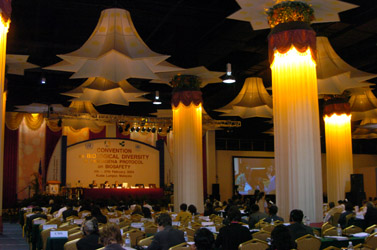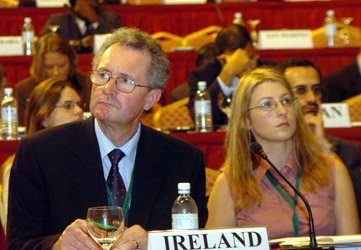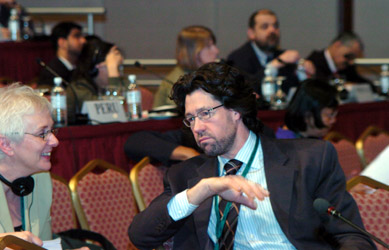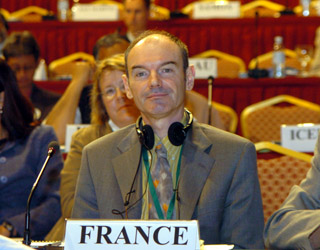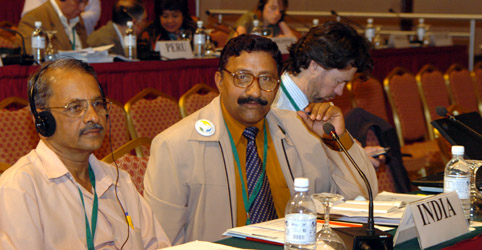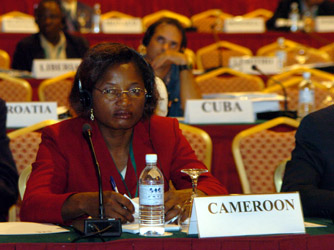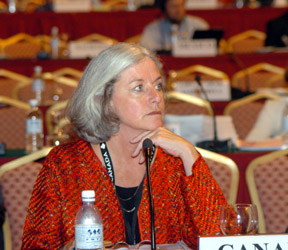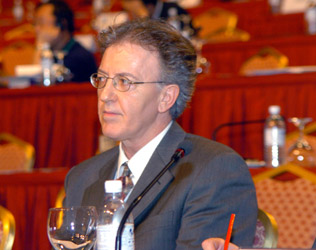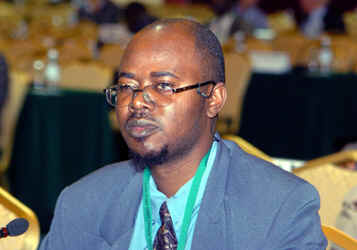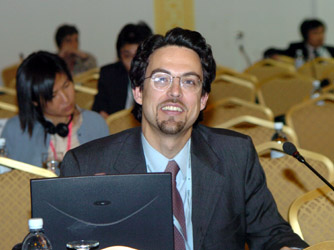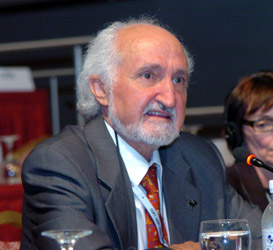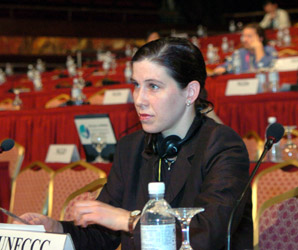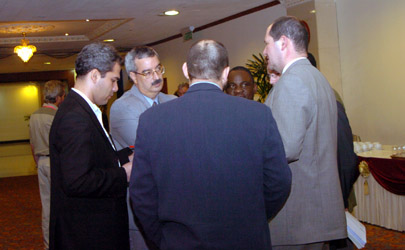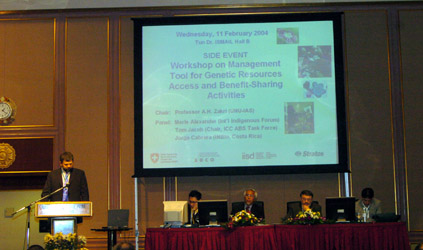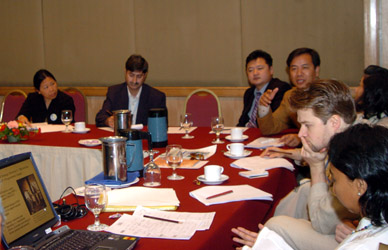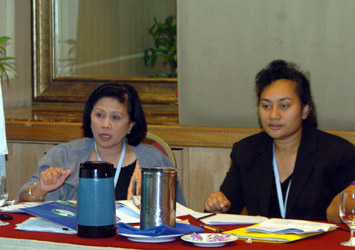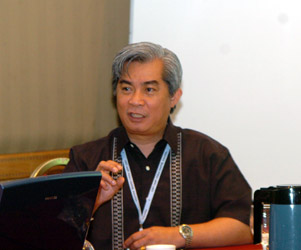|
7th CONFERENCE OF THE PARTIES TO THE CONVENTION ON BIOLOGICAL DIVERSITY (COP-7) Kuala Lumpur, Malaysia; 9-20 February 2004
Highlights
for Thursday 12 February 2004 COP-7
delegates met throughout the day in two Working Groups (WGs). WG-I
considered the Strategic Plan, and progress reports on thematic work
programmes. WG-II discussed Article 8(j) (traditional knowledge), and
scientific and technical cooperation and the Clearing-house Mechanism (CHM).
A brief daily Plenary was held in the afternoon. Contact groups on access
and benefit-sharing (ABS), the programme budget for the biennium
2005-2006, and protected areas (PAs) also convened. |
|||||||||||||||
Ireland,
on behalf of the EU and Acceding Countries, Bulgaria and Romania (EU),
proposed establishing an expert liaison group to develop trial indicators.
Above photo L-R: Noel Foley and Deírdre Lynn delegates from
(Ireland)
Iceland said the proposed targets are insufficiently developed. Above photo: Sigurdur Thráinsson (Iceland)
Saudi
Arabia, on behalf of the ARAB GROUP, underlined the linkages between the
different thematic work programmes.
Above photo: Mohammad Al-Sakhan (Saudi Arabia)
France stressed the need for criteria and indicators for sustainable forest management (SFM). Above photo: Jean-Pierre Le Danff (France)
|
|
|
|
|
|
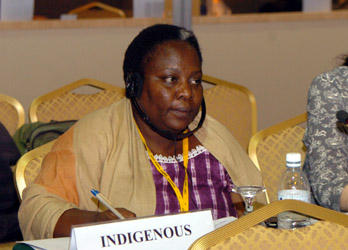
The
IIFB delivered the opening statement stressing the inherent rights of
indigenous peoples to PIC and sui generis systems for the protection of
traditional knowledge, while opposing mainstream intellectual property
rights and GURTs. Above photo: Lucy Mulenkei (IIFB)
Namibia supported a voluntary funding mechanism for indigenous
participation. Above photo: Sem Shikongo (Namibia)
Austria called for the respect of territorial rights of indigenous peoples necessary to maintain traditional knowledge and also integral to sui generis systems for the protection of traditional knowledge Above photo: Andrea Nouak (Austria)
The
FAO said the ITPGR covers essential parts of agricultural biodiversity,
urging Parties to ratify it. Above photo: Jose Esquinas-Alcazar (FAO)
The UN FRAMEWORK CONVENTION ON CLIMATE CHANGE said its Subsidiary Body for
Scientific and Technological Advice has encouraged Parties to use the report
of the AHTEG on Biodiversity and Climate Change as a source of information.
Above photo: Rocio Lichte (UNFCCC)
|
|
|
|
Above photos: Regarding the goals and targets of the draft work programme on protected areas (PAs), delegates debated language on indigenous involvement in PA establishment and management. Friends of the Chair groups were established to address targets on securing resources to meet PA costs and monitoring systems. |
|
This workshop gave participants the opportunity to discuss the approaches to, and challenges involved with, developing a management tool to help guide the implementation of the Bonn Guidelines. The management tool is targeted at non-State actors, and seeks to facilitate the establishment of collaborative relationships between providers and users of genetic resources (GR). Discussion focused on the potential value of such a tool as a way to obtain more experience in implementing the Bonn Guidelines. It was suggested that the Bonn Guidelines are more detailed in the information provided to States, and that there is a need for additional guidance to non-State actors involved with and effected by ABS activities.
Some of the specific comments included:
- Many users of GR are not familiar with their obligations under the CBD;
- There is a need for a practical tool – not limited by what can be negotiated;
- A management tool might help build experience with implementing ABS;
- A management tool could help to address some key challenges, including:
- The lack of market information during PIC and MAT negotiations;
- The need to 'level the playing field';
- The transfer of GR to or through third parties;
- Monitoring and tracking implementation of PIC and benefit-sharing agreements; and
- The lack of a framework for entering negotiations.
- Participants also highlighted some sensitive issues that would need to be considered, including:
- Giving customary users and indigenous peoples a formal role;
- Addressing the stock of ex situ material already in use;
- The link between PIC and IPRs; and
- The relationship between the State and other users.
For more information please see: www.iisd.org/standards/abs.asp or contact Tom Rotherham (IISD) trotherham@iisd.ca or George Greene (Stratos) ggreene@stratos-sts.com.
|
Links |
|
|

